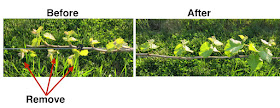We love Chenin Blanc! Almost half of our vineyard is planted in Chenin Blanc. So, you will find us celebrating National Chenin Blanc Day which this year is on June 15th, next Friday.
Our love of Chenin Blanc began after tasting
Domaine Huet and was made more indelible after reading
Wine and War by Don and Petie Kladstrup. In the introduction to this book published in 2001, Don and Petie Kladstrup recount the time they went to visit Gaston Huet and he let them taste a wine which he brought up from his cellar. The Klatstrups first guessed that it was a 1976, a great year in the Loire Valley. Wrong. They guessed 1969, 1959, 1953 and they were wrong each time. The wine that they were drinking was Gaston Huet's 1947 vintage. They wrote that it tasted like honey and apricots, lusciously sweet, yet fresh and alive. Yes, that is Chenin Blanc!
My next recollection of having a refreshing Chenin Blanc was in 2011, when we had a
2009 Petit Chenin made by South Africa's Ken Forrester. We had paired the wine with raw oysters and it was heaven!
Also in 2011, I was taking the U.C. Davis online Enology and Viticulture course and needed to know what kind of vines, rootstock and clones our hypothetical vineyard would be planted with. During an online search, I learned that Charles Massoud, owner of
Paumanok Vineyards had planted Chenin Blanc! So, in fulfillment of my course requirement, I emailed him and got a response from Charles within 24 hours! The story of Charles' Chenin Blanc plantings is also very interesting and full of serendipity. In a 2011 article called
The Massoud Family & Paumanok Vineyard: Leading Vintners of Long Island’s North Fork in the Huffington Post, Kareem Massoud, son of Charles Massoud recounts the story of his father's entry into growing Chenin Blanc:
“Paumanok’s Chenin plantation was pure serendipity. My parents had no intention of planting Chenin when we first bought the farm. The Chenin vines came with a property they purchased across the street. My father had begun to rip out the vines. As the growing season moved in on him, he ran out of time. A German vineyard caretaker at the time encouraged my father to leave the vines and give them a chance as they appeared ‘happy and healthy here’. And so he did. Chenin does in fact grow well here...Year in and year out , it consistently produces a wine that is fresh, crisp, and redolent of citrus fruits, especially grapefruit.”
So, get yourself some Chenin Blanc and celebrate on June 15th, National Chenin Blanc Day. When you do, consider this
Chenin Blanc Wine Aroma Wheel prepared by Stellenbosch University’s Institute for Wine Biotechnology, Department of Viticulture and Oenology, Chenin Blanc Association of South Africa, Platter’s South African Wine Guide and Chenin Blanc producing cellars. See where on the Aroma Wheel your Chenin Blanc falls. Happy Drinking!


















